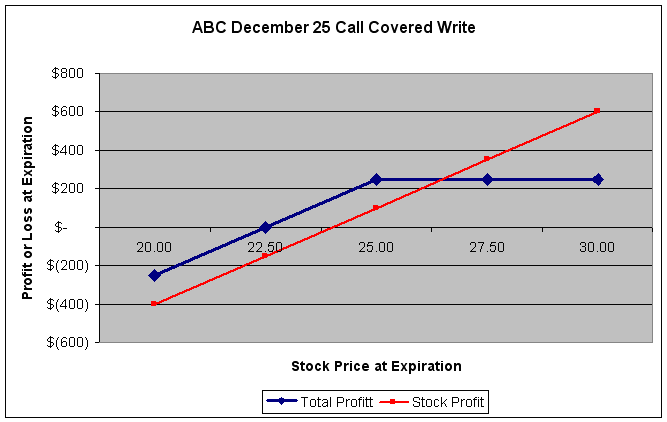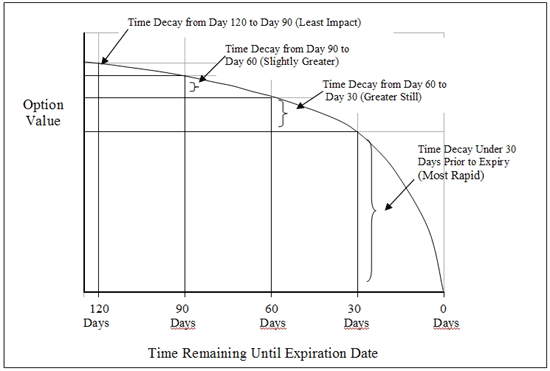

Writing covered calls gives you an additional tool to beat the market. Writing covered calls is a conservative approach that can enhance your overall return while lowering the risk. Writing covered call options helps to improve the total return of an equity investor’s portfolio, if they apply several important principles.
By the way covered calls are approved for use in Individual Retirement Accounts (IRA) as they are considered a conservative way to use options by the authorities.
Writing a covered call is a strategy where an equity investor sells a call option while they own the necessary number of shares of the underlying stock. One of the objectives of a writer of an equity covered call is to reduce the risk of a small decline in the price of the underlying stock. The writer of a covered call also seeks to increase the overall performance from owning the stock by collecting option premiums that are received from the buyer of the option.
A call option is a financial contract between two parties, a buyer and a seller of the of the option and it is normally called a "call". The buyer of the option has the right, but not the obligation to buy an agreed quantity of a stock (the underlying instrument) from the seller of the option by a certain time (the expiration date) for a certain price (the strike price). The seller (or "writer") is obligated to sell the stock should the buyer so decide. The buyer pays a fee (called a premium) to the seller for this right. To write a covered call someone must agree to be the buyer of the equity covered call option.
As an investor who owns a stock, you have the right to sell that stock at any price as long as their is a willing buyer. Writing an equity covered call is selling that right to sell your stock. In return you receive a premium that you get to keep. Investopedia has more information on call options if you are interested.
The decay of the time premium of an option creates the profit opportunity from writing covered call options. The time premium of an option accelerates its decay as it gets closer to the expiration date. The chart below from trading-plan.com is one of the best I have seen depicting the decay of the time premium of an option. This time decay is key element of the covered call writer’s strategy. Notice that the option starts to decay more rapidly at about the 60 day time period and then accelerates further with 30 days to go.

Generally, the writer of an equity call option is expecting the price of the underlying stock to rise no further than the strike price by the time the option expires, so they retain the appreciated value of the stock, any dividends that have been paid and the premium they received from selling the covered call option. However, if the price of the stock makes a strong upward move, then the covered call option writer will not fully participate in the gain from the stock.
If an investor uses the correct covered call strategy, they can improve the total return of their portfolio and reduce the volatility they usually experience. If done properly, an investor can increase the performance of their portfolio 5 to 10% per year, depending on the option strategy they chose.
When using a covered call writing strategy it is important for the investor to quantify the potential profit and break-even point of the transaction. Fortunately, there is a simple formula to calculate these performance factors.
The best way to illustrate this point is with an example. Assume company ABC was selling at 24.00 when you decided to write a December 25 covered call. The bid on the call was 1.50. The table below describes details necessary to determine the max profit potential and downside break-even point for covered call option.
There are several observations that should be noted. First, the down side protection is $1.50 per share, the premium received from the option. This makes the stock price downside break-even point 22.50, protecting your stock position to this level. Second, the maximum profit potential for this position during its life is $250, $150 from the option premium and $100 from appreciation of the stock to 25.00 or higher. Third, any appreciation in the stock above the sum of the premium from the covered call plus the price of the shares when the call was sold is lost as the value of the call rises above the premium you received after that point.
|
The ABC December 25 Covered Call |
||||
|
ABC Price at Expiration |
Stock Profit |
December 30 Call at Expiration |
Call Profit |
Total Profit |
|
20.00 |
$ (400) |
0.00 |
$ 150 |
$ (250) |
|
22.50 |
$ (150) |
0.00 |
$ 150 |
$ - |
|
24.00 |
$ - |
0.00 |
$ 150 |
$ 150 |
|
25.00 |
$ 100 |
0.00 |
$ 150 |
$ 250 |
|
27.50 |
$ 350 |
2.50 |
$ (100) |
$ 250 |
|
30.00 |
$ 600 |
5.00 |
$ (350) |
$ 250 |
The chart below graphically presents the analysis of the ABC December 25 Covered Call write. Notice the shape of the Total Profit curve. This will always be the shape of a covered call write. Also notice that the maximum profit always occurs at all stock prices equal to or greater than the strike price, as long as the position is held until it expires.
As the option gets closer to expiration and the price of the stock of ABC rises to and above the strike price, you are faced with some alternatives. First, you could do nothing in which case the covered call will likely be assigned at expiration and your stock would be “called away” at the strike price. You would retain all the price appreciation in the stock from the price you acquired the stock to the strike price and you also keep the premium you received when you sold the covered call. However, you will no longer own the stock.
The other alternative you have is to buy back the covered call at the current price. If the shares of ABC are trading at 27.50 then the price of the option will be at least 2.50 plus any remaining time premium. In this case you will incur a loss by buying back the option, but you will keep your stock that has appreciated to 27.50. Your profit remains at $250, however, since you still own the stock you can participate in any further appreciation in the price of the shares. You also will experience any decline in the price of the shares as well. The downside protection from writing a covered call is limited to the value of the company’s stock minus the cash received from writing the option.
The third alternative is to hold the option until it expires, if the price of the shares remains below the strike price. In this case your profit will be the option premium received and any appreciation in the price of the stock up to the strike price. If the option expires worthless, you keep the option premium and the shares of the underlying security. If the shares decline in price you can still hold the option until expiration as the premium helps to offset some of the price decline.

Basically, the strategy of owning stock and writing covered calls is to outperform the ownership of stock alone. This works as long as the price of the stock rises a little, remains the same or falls slightly. Also, by consistently writing covered calls your portfolio will show less volatility than just holding the stock alone. The article Covered Call Expiration explains in more detail strategies investors can take as their covered call option approaches expiration.
Looking at a listing of call options, you will notice that there are two categories listed, in-the-money and out-of-the-money. A call option is termed in-the-money when the strike price is below the market price of the underlying asset. When the strike price of a call option is above the underlying market price of the asset it is termed out-of-the-money.
Generally speaking, the in-the-money covered call write offers the investor more downside coverage, while the out-of-the-money covered call write offers higher potential profit with less down side risk protection.
The table below depicts the profitability of writing an in-the-money and an out-of-the-money covered call for a stock that is selling at 22.50 with the December 20 call selling for 4 and the December 25 call selling for 0.50. Notice that the in-the-money write has downside protection to 18.50, while the out-of-the-money write downside protection only goes to 22.00. On the other hand the upside on the in-the-money write is limited to $150, while the out-of-the-money write is $300. Basically, the out-of-the-money profit potential of writing a covered call is greater than what you would receive from an in-the-money covered call write. The maximum profit potential of an out-of-the-money covered write always requires the underlying stock price to rise.
|
Comparison of In-the-Money and Out-of-the-Money Covered Call Options |
|||
|
In-the-Money Write of December 20 |
Out-of-the-Money Write December 25 |
||
|
Stock at Expiration |
Total Profit |
Stock at Expiration |
Total Profit |
|
17.50 |
$ (100) |
17.50 |
$ (450) |
|
18.50 |
$ - |
20.00 |
$ (200) |
|
20.00 |
$ 150 |
22.00 |
$ - |
|
22.50 |
$ 150 |
22.50 |
$ 50 |
|
25.00 |
$ 150 |
25.00 |
$ 300 |
|
30.00 |
$ 150 |
30.00 |
$ 300 |
When considering writing a covered call, your view of the underlying stock should be to go up over time, remain at the same level or possibly decline slightly. If you believe the price of the stock will decline more significantly, then you should consider selling the stock or employ other more appropriate option strategies such as buying a protective put. The article Total Return Approach to Covered Call Option Strategies provides more detail on how to evaluate covered call options strategies.
If you are looking to improve the return on your portfolio then you might consider writing covered calls on the stocks in your portfolio. It is important to understand the potential profit that the covered call offers to you before making a decision. Options with different strike prices including those that are in-the-money and those that are out-of-the-money will offer different profit potential and downside protection. Understand these factors are the first steps to learning analyze what covered call option to use to help improve the overall return of your portfolio.
If you want to learn more about using options consider reading Options Made Easy: Your Guide to Profitable Trading (2nd Edition) by Guy Cohen. It is a good way to help you to get started learning how to use put options to reduce your down side risk.